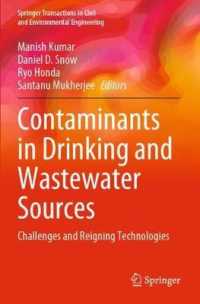- ホーム
- > 洋書
- > 英文書
- > Politics / International Relations
Full Description
Elgar Research Agendas outline the future of research in a given area. Leading scholars are given the space to explore their subject in provocative ways, and map out the potential directions of travel. They are relevant but also visionary.
This timely Research Agenda highlights how slow violence, unlike other forms of conflict and direct, physical violence, is difficult to see and measure. It explores ways in which geographers study, analyze and draw attention to forms of harm and violence that have often not been at the forefront of public awareness, including slow violence affecting children, women, Indigenous peoples, and the environment.
Demonstrating a range of research methods and theoretical perspectives, this Research Agenda looks at the topic of slow violence through qualitative fieldwork, document analysis, geospatial technologies and cartographic analysis and representation. Key case studies consider slow violence in the form of social injustice, environmental alteration, and harmful human-environment interactions. The chapters also highlight how physical infrastructure, social and legal practices, places that have experienced armed conflict, and groups of people being labeled or marginalised can foster forms of slow violence.
Scholars and students of human geography, particularly those looking at decolonization, environmental and social justice and different geographic methods for research, will find this book to be a beneficial read. It will also be useful for those studying structural harm and indirect violence more widely.
Contents
Contents:
1 Geographies of slow violence: an introduction 1
Shannon O'Lear
2 Geography, time, and toxic pollution: slow
observation in Louisiana 21
Thom Davies
3 Rhythms of crises: slow violence temporalities at
the intersection of landmines and natural hazards 41
Ruth Trumble
4 Complicating the role of sight: photographic
methods and visibility in slow violence research 57
John Paul Henry
5 Tourism development as slow violence:
dispossession in Guatemala's Maya Biosphere Reserve 73
Jennifer A. Devine, Hannah L. Legatzke, Megan
Butler and Laura Aileen Sauls
6 From violent conflict to slow violence: climate
change and post-conflict recovery in Karamoja, Uganda 89
Daniel Abrahams
7 Enduring infrastructure 107
Kimberley Anh Thomas
8 Slow violence and its multiple implications for children 123
Sheridan Bartlett
9 For Indigenous youth: towards caring and
compassion, deconstructing the borderlands of
reconciliation 137
Joseph P. Brewer II and Jay T. Johnson
10 The infliction of slow violence on first wives in
Kyrgyzstan 155
Michele E. Commercio
11 When rednecks became meth heads: cultural
violence, class anxiety, and the spatial imaginary 173
Aaron H. Gilbreath
12 The slow violence of law and order: governing
through crime 189
Samuel Henkin and Kelly Overstreet
13 Dark cartographies: mapping slow violence 205
Peter Vujakovic
14 Closing thoughts and opening research pathways
on geographies of slow violence 225
Shannon O'Lear
Index 233








